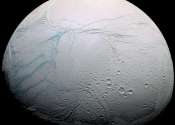Scientists map sulfur residue on Jupiter's icy moon Europa
A Southwest Research Institute-led team used the Hubble Space Telescope to observe Jupiter's moon, Europa, at ultraviolet wavelengths, filling in a "gap" in the various wavelengths used to observe this icy water world. The ...









